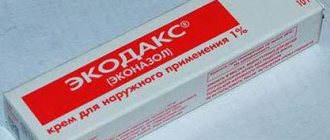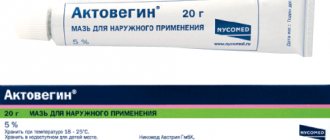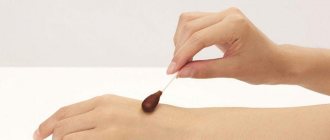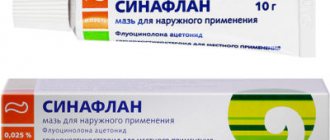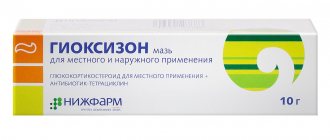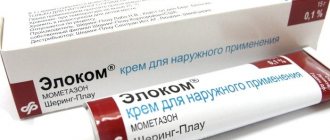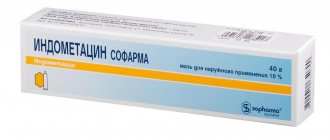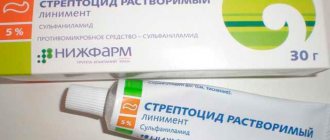Turpentine ointment is an external medicine based on natural ingredients, according to the instructions for use, it is prescribed for the treatment of rheumatism, neuralgia, pain and inflammatory processes in skeletal muscles, bruises, sprains. The drug also turns out to be effective in the complex treatment of patients with respiratory diseases, and is used as a way to combat lice and cellulite.
Turpentine ointment is often included in universal home first aid kits. This external remedy owes its popularity to its wide range of therapeutic effects, low toxicity and accessibility. More information about the properties, mechanism of action, dosage regimen can be found in this article.
Composition and release form
Turpentine ointment contains 1 main component, which is responsible for the therapeutic effect - turpentine oil or otherwise known as gum turpentine. Its first name is associated with the composition of turpentine - a product of distillation of resin, which is formed when cutting coniferous trees, mainly pine. The active substance contains many different compounds - terpenes and their derivatives with diverse effects on the body.
Additional components in the composition: Vaseline, purified water. The drug is a creamy white mass with a slight yellowish tint. The ointment has a specific smell of turpentine.
The drug is produced in jars and tubes with a volume of 20 to 50 g, sealed in cardboard packages with instructions inside.
Description of the drug
Visually, turpentine ointment looks like a homogeneous thick white mass with a yellowish tint, which has a specific odor. It is used to treat both chronic and acute diseases of the joints and spine. It helps reduce various symptoms, including joint stiffness and pain. Orthopedic doctors advise using the drug immediately when signs of the disease appear, such as nagging and aching pain, as well as a feeling of stiffness in movements. Using a warming ointment at the first symptoms of the disease will prevent the disease from going into an exacerbation stage.
What does Turpentine ointment help with:
- for diseases of a rheumatic nature after localization of the acute stage of inflammation;
- with manifestations of degenerative-dystrophic diseases of the spine and joints;
- for pain caused by pinched nerve endings;
- with spasms of skeletal muscles;
- for discomfort and pain caused by the formation of heel spurs;
- for pain in the spine and discomfort due to a herniated disc;
- for the treatment of respiratory diseases complicated by the formation of viscous, thick sputum in the upper respiratory tract.
Also, the use of this product promotes recovery from injuries of both small and large joints. Traumatologists recommend using it during the rehabilitation period after dislocation, subluxation, as well as ruptures of ligaments, tendons and muscles.
pharmachologic effect
Turpentine ointment is a local, irritating herbal remedy. It has an antiseptic and local distracting effect. The active substance quickly passes through the epidermis, irritating the nerve endings. The therapeutic effect is also associated with the activation of endogenous biological substances. The amount of inflammatory mediators increases due to increased blood flow, which is manifested by redness of the skin and slight swelling. Endorphins and enkephalins reduce the severity of pain.
In general, turpentine ointment has the following effects:
- Annoying. The active substance affects the receptors of nerve endings located in the skin, due to which a reflex response is observed.
- Warming. Gum turpentine helps dilate blood vessels, increasing blood flow to the area where the ointment is applied, which causes slight redness. Due to this, the severity of pain and inflammation decreases. Due to blood flow, the number of endogenous enzymes that are involved in stopping pathological processes increases.
- Distracting. Due to local skin irritation and burning after application of the drug, the feeling of pain is reduced.
- Antiseptic. Turpentine ointment destroys a number of pathogenic organisms located on the skin and prevents their reproduction. The drug is also used to prevent head lice.
The product has an expectorant and mucolytic effect. When applying the ointment to sensitive areas of the chest, a cough reflex is observed, due to which the airways are cleared of phlegm and mucus. It quickly liquefies and is eliminated naturally.
Read more What is Flucinar gel used for: instructions and analogues
Description of the medicine
Turpentine ointment has unique properties and completely disinfects the wound or damage to which it is applied. The drug has an irritating effect, so it is often used to remove lice. The ointment also has an analgesic effect and is suitable for the treatment of injuries and diseases of the musculoskeletal system.
The drug contains an active ingredient – purified turpentine. It is thanks to this that the ointment easily penetrates the skin and has a healing effect as quickly as possible.
Thanks to the action of turpentine oil in the composition, the drug immediately affects the nerve endings and relieves pain. Coniferous pine in the preparation has a beneficial effect on the skin.
Doctors noted that when the ointment is applied to the skin, two reactions begin. The first comes from the therapeutic effect on the affected area. And the second reaction occurs due to the irritating effect of the ointment composition on the skin. Therefore, you need to remember that the ointment may cause slight inflammation on the body, redness or itching. This is due to the specific composition of turpentine ointment. With all these side reactions, the drug works great and copes with pain symptoms.
Turpentine ointment is often used to treat coughs. This is no coincidence, because thanks to its unique components, the drug has a mucolytic and expectorant effect. If you apply the ointment to the chest, the cough will go away in about 3 days.
What does turpentine ointment help with?
According to the instructions, turpentine ointment is used for:
- acute, chronic diseases of the respiratory tract;
- radiculitis;
- rheumatism;
- Do not lie;
- myalgia;
- neuralgia;
- arthralgia.
Doctors prescribe a local distraction agent to:
- eliminate pain and discomfort in muscles and joints;
- improve blood flow to pathological areas;
- restore mobility and range of motion in joints;
- eliminate muscle stiffness and heaviness in the legs;
- disinfection of skin;
- accelerating recovery after muscle strain;
- additional treatment of wet cough.
After application to the skin, the ointment is very quickly absorbed and penetrates to the pathological focus. A person experiences a feeling of tingling, warmth, and a slight burning sensation. Due to the rush of blood, the skin becomes noticeably red, the pain gradually subsides, and the muscles relax.
Price
You can buy the medicine at any pharmacy.
The product is also sold through online stores. Available freely, without a prescription.
The average cost of a tube with a capacity of 25 g is 25-30 rubles .
The price varies depending on the regional location of the pharmacy, distance from the regional center, and manufacturer.
Instructions for use of turpentine ointment
To quickly get rid of a wet cough and remove phlegm, eliminate the symptoms of ARVI or other diseases of the respiratory system, the drug is applied to the chest area. The ointment is lightly rubbed with massaging movements into dry, clean skin. Additionally, it is recommended to apply it to the feet. Repeat the procedure up to 3 times a day. The product is not recommended to be applied to the area of the nipples and heart. After the procedure, it is forbidden to go outside so as not to cause hypothermia. Duration of treatment is 2-3 days.
For muscle and joint pain, turpentine ointment is applied in a thin layer only to the affected area, without affecting healthy areas. Rub in light circular movements until absorbed. Warming compresses are allowed. After application, cover the treated area with gauze and wrap it in a blanket or warm scarf. The procedure can be repeated up to 3 times a day. The duration of use is on average 10 days. Repeated treatment after a break of 1 month.
From ticks and other parasites
Turpentine has a toxic effect on various small insects, such as:
- lice;
- bedbugs;
- ticks.
In the treatment of pediculosis, the drug is used as follows:
- Squeeze out the amount of ointment required for the entire scalp and rub evenly into the scalp with massage movements.
- Wrap your head in a towel, after wrapping it in plastic wrap, and leave for 2-3 hours.
- Then you need to carefully comb out the dead lice and their eggs from your head and hair several times.
- Rinse everything off with regular shampoo, thoroughly massaging your head.
It is not recommended to do this procedure several times a day; once a day for about 3-4 days in a row is enough (as needed).
When using this product, it is worth keeping in mind that it comes in a rather greasy consistency and is difficult to wash out of the hair, so after drying it may remain greasy in appearance.
The use of turpentine ointment for pediculosis
Gum turpentine in the composition of the drug is effective against pediculosis. The ointment, due to its oily texture, envelops the hair, creating a film that prevents parasites from breathing. The product is effective only on adults. Due to local irritation of the skin, itching is eliminated. The product is applied to the root part of the hair, then distributed throughout the entire hair, wrapped in a plastic cap or a regular bag. The ointment is left on the hair for 1.5 hours so that the active substance has time to act. After using a metal comb, nits and lice are carefully combed out. Wash your hair with regular shampoo.
Read more How to use Voltaren gel - instructions and analogues
Reviews
Valeria, Nizhny Novgorod
I asked a dermatologist if it was possible to use Turpentine ointment for acne. The doctor categorically prohibited this method of treating acne, since the drug would only increase inflammation.
Oksana, Izhevsk
I always use turpentine ointment at the first sign of exacerbation of cervical osteochondrosis. It quickly relieves pain that occurs when trying to turn or tilt your head.
Read further:
Ibuprofen ointment and gel: detailed instructions for use, review of analogues and reviews
Butadione ointment: detailed instructions and recommendations for use, composition, review of analogues and reviews
Acyclovir Hexal: instructions for use of cream and reviews
Indomethacin ointment: instructions for use, review and reviews
Traumeel for children and adults: instructions for use of ointment and gel, review and reviews
Turpentine ointment (review) from 20 rub.
Overall
4.8
- Efficiency
- Price
- Safety
- Availability
Pros
- Efficiency
- Price
Cons
Use in children
In children, the product is often used for head lice. The effect of the active substance on the children's body is not precisely known, so its use in other cases is limited. According to the instructions, the use of ointment in children under 2 years of age is strictly prohibited. Under the age of 18, the product can be used with the permission of a pediatrician.
If necessary, children are often advised to apply the ointment after mixing it with any baby cream in a 1:1 ratio. The drug will have its therapeutic effect, but the likelihood of severe burning and possible burns is reduced. Before starting treatment, it is recommended to conduct an allergy test - apply a small amount of the drug to a healthy area of skin.
Indications and contraindications for use
Most often, turpentine ointment is used to eliminate coughs during colds, as well as after them, if the cough is a residual phenomenon after an illness. This remedy promotes the dilation of blood vessels, warms the internal organs well and enhances the effect of other drugs used. To avoid burning sensitive baby skin, the drug is mixed in equal proportions with soft baby cream, honey or badger fat. This drug is applied to the feet (then put on socks), as well as to the area between the shoulder blades and the sternum, avoiding the area where the heart is located. These areas are rubbed well, after which the child is wrapped in blankets so that his body warms up well.
To enhance the effect, you can give your child warm raspberry or herbal tea to drink before rubbing.
However, it is important that he does not have a high temperature, since at a temperature above 38 degrees this remedy should not be used - it will put an increased load on the heart.
This drug can be used in a similar way in the presence of various acute and chronic diseases of the upper respiratory tract. It can be effective for ARVI, bronchitis,... For a speedy recovery of the patient, it is recommended to take this remedy 2-3 times a day until the cough is completely eliminated.
Like any other medical product, this ointment also has its contraindications. These include:
- Kidney failure;
- Individual immunity to certain components of this drug;
- Liver failure;
- Various dermatitis;
- The presence of cuts, ulcers, and inflammations on the skin.
If you are not sure that this drug is suitable for your child, be sure to consult your doctor about its use. If this is necessary, it is worth undergoing a full examination to exclude any contraindications.
During pregnancy
This remedy should not be used by women throughout the entire period of pregnancy, as well as during breastfeeding. This rule can be violated only if such an ointment was prescribed by a doctor, and if the effect expected from its use exceeds the level of danger of such a remedy for the body of the expectant mother or her fetus. If we are talking about self-medication, such an ointment should not be used under any circumstances.
For small children
Turpentine ointment is only suitable for children over two years of age. In the vast majority of cases, any rubbing is contraindicated for children under this age, so this ointment should not be used for them either.
An exception can only be made if such rubbing has been prescribed for your baby by a doctor. Unauthorized use of this drug for children under 2 years of age is dangerous.
Side effects
Negative reactions are rare and may include:
- itching;
- swelling;
- rash;
- severe redness.
An allergic reaction may cause dizziness, decreased blood pressure, and an attack of suffocation, which requires calling an ambulance and appropriate therapy. If side effects occur, the ointment should be quickly washed off the skin with plenty of water.
After applying the product, tingling, slight burning, and redness of the skin occur. These signs are not side effects - this is how the active substance works. Symptoms go away on their own within 5-15 minutes. Due to the strong specific odor, slight dizziness, headache, and nausea may occur.
Turpentine baths
Turpentine baths are a special method of therapy in which the patient is placed in a freshwater bath with the addition of a turpentine-based emulsion or solution. Scientists suggest that they have a restorative effect on dried tissues, providing them with oxygen, as well as improving microcirculation in blood vessels and capillaries.
The caustic soda contained in the solution promotes looseness of the skin, which facilitates the therapeutic effect of turpentine. Castor oils and oleic acids are also added to the bath, which soften the irritating properties of the main substance.
After taking such baths, patients note an analgesic and anti-inflammatory effect, which is reflected in the elimination of symptoms of arthritis, rheumatism and other similar diseases.
Due to the peculiarities of the effect of turpentine on the cardiac system, when carrying out such a procedure it is necessary to control the level of blood pressure.
Also, before such a bath, it is recommended to lubricate sensitive areas of the body with Vaseline: the groin area, nipples, and armpits in men and women.
Features of the physiotherapy:
- The water temperature does not exceed 38 degrees.
- The duration of the procedure is about 15 minutes, no more.
- The course of treatment is from 10 days with breaks of a day or two.
If an allergy occurs, the physiotherapy procedure should be stopped immediately.
Contraindications, overdose
Turpentine ointment, like other medicines, has a number of restrictions for use:
- pregnancy;
- breastfeeding period;
- skin diseases;
- severe pathologies of the kidneys and liver;
- skin damage in the form of abrasions, scratches, cuts, cracks, etc.;
- allergic reaction to components in the composition;
- age up to 2 years.
Caution when using is necessary for people with severe cardiovascular diseases.
With frequent use or applying a large amount of ointment, an overdose may occur:
- chemical burns;
- skin rashes;
- decreased blood pressure;
- deterioration of general condition.
If these symptoms appear, consult a doctor and, if necessary, symptomatic therapy.
Indications for use
To treat joints, turpentine ointment can be used as an independent type of therapy or in combination with other methods and medications. This product of natural origin can act as a substitute for non-steroidal drugs.
What does the medication help with according to the manufacturer’s instructions:
- rheumatism;
- various types of neuralgia;
- neuritis;
- myositis;
- myalgia;
- sciatica;
- arthralgia;
- radiculopathy;
- colds, ARVI, bronchitis, other diseases of the respiratory system, manifested by cough, runny nose.
Let us also note the benefits of taking turpentine baths. But it is imperative to comply with the doctor’s instructions and strictly follow the instructions.
Additional Information
When using turpentine ointment, make sure that the product does not get into the eyes or mucous membranes. If this happens, rinse quickly with plenty of water and consult a doctor. Interaction with other drugs is not indicated. The ointment should not be applied to damaged skin, as this can cause severe burning and other unpleasant symptoms. If a person has sensitive skin, it is recommended to mix the ointment halfway with baby or regular hypoallergenic hand cream.
Read more Cream Pimafucin - instructions, price and reviews
The product should not be applied at elevated temperatures due to its warming effect, which can provoke an even greater increase in temperature. Turpentine ointment should be stored away from small children and direct sunlight at a temperature not exceeding 15°C. After each use, close the lid tightly. Shelf life is 2 years from the date of release, which the manufacturer indicates on the packaging. The drug can be bought at a pharmacy without a doctor's prescription.
The average cost of turpentine ointment with a volume of 50 g is 60 rubles.
Directions for use and dosage
According to the manufacturer's instructions, medicinal cream Turpentine ointment for coughs should be applied to the back in the lung area, chest and feet. When rubbing the back and chest, avoid the ridge line. Also, do not rub the medicine in the area where the heart is located or apply it to the nipples. The drug can only be used externally.
To treat cough in adults and children, the ointment can be applied 1-2 times a day, mainly in the evening, before bedtime. The body must be clean. After rubbing, the patient puts on clothes made of natural breathable fabrics, linen or cotton. It is advisable to wear socks on chafed feet and do not take them off for 1-1.5 hours. If you are not allergic, it is advisable to use wool socks.
Treatment of cough with turpentine ointment can last for 1 week. If during this time the therapy does not produce a positive result, you should consult your doctor to change the drug.
To treat cough in adults and children, the ointment can be applied 1-2 times a day, mainly in the evening, before bedtime.
The dosage of the drug during treatment is individual and depends on the age of the patient, as well as the size of the tissue being treated. For a child, the ointment is applied in a thin layer and thoroughly rubbed over the skin. Typically, when rubbing children's backs, an amount of ointment comparable in size to a small pea is used. A strip 3-5 mm long is squeezed out of the tube.
To treat cough in an adult, the ointment is also applied in a small layer and intensively rubbed over the skin. The amount of ointment to apply to the back can be compared to a medium-sized bean. The length of the squeezed-out strip of ointment is 1.3-1.5 cm. For rubbing the chest and feet, this amount is approximately halved.
If after applying the ointment the patient’s condition worsens, the areas where the medicine was applied should be thoroughly washed with warm water and soap. After this, the ointment cannot be applied. For further treatment you should consult a doctor.
Analogs
Drugs for topical use with similar effects include:
- Camphor oil.
- Balm Golden Star.
- Viprosal V.
- Bom Benge.
- Warming patches.
The closest analogues that contain the same active substance as turpentine ointment: pure turpentine oil, gels, creams, balms from Skipar, Monastic collection ointment-balm.
Storage conditions and periods
This medicine should be stored in a dark place at a temperature of 5°C to 20°C. If the temperature regime is not observed, the ointment changes color, smell and consistency. This is an indication that it has deteriorated. The drug can be stored unopened for 2 years. After opening the tube, the shelf life of the ointment is 1 month. Children should not be able to take the medicine themselves. Getting it in the eyes, mouth or nose causes an unpleasant feeling of cutting and burning, as well as pain.
Nicoflex
| This article violates the rule against instructions in encyclopedia articles. Its text almost completely repeats the instructions for use of the drug provided by its manufacturer. In addition, the data provided may not be sufficiently objective and reliable (especially regarding the effectiveness and safety of the drug). To maintain neutrality of presentation, it is necessary to rework this article based on independent authoritative sources of information. |
